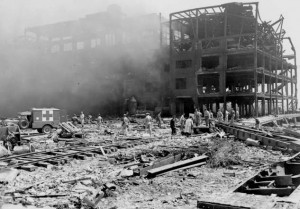Sayonara Crossroads
Dear Friends,
At the intersection of technology, finance and the Pacific Rim.
Dear Friends,
Everything that can be counted does not necessarily count; everything that counts cannot necessarily be counted.
 Accidents happen to the best of companies. It is how those companies respond to big industrial accidents — how they learn and change as a result of those lessons — that shows the quality of an organization. One of the many readers to comment to me this week on BP’s situation in the Gulf of Mexico put it in the context of his own experience working as an engineer at Monsanto Chemical. His lesson is so compelling that I have reproduced it below in its entirety — Bob.
Accidents happen to the best of companies. It is how those companies respond to big industrial accidents — how they learn and change as a result of those lessons — that shows the quality of an organization. One of the many readers to comment to me this week on BP’s situation in the Gulf of Mexico put it in the context of his own experience working as an engineer at Monsanto Chemical. His lesson is so compelling that I have reproduced it below in its entirety — Bob.
In 1947 a tanker blew up in Texas City harbor, ironically the same city where BP had a big refinery accident in 2005. The 1947 explosion leveled Monsanto’s plant, killed hundreds and destroyed thousands of homes. It registered on seismographs as far away as Denver. While the accident was not Monsanto’s fault, it alerted management to the destructive power of a chemical process and provided the motivation to get super serious about safety. Of course back then most of the company’s management had engineering degrees and thoroughly understood the chemistry and physics involved. That, too, is probably a big difference with today’s industry. Few executives today have engineering or science degrees.
When I joined Monsanto in the late ’70’s they put their new hires through a three day course on the company. A couple hours were dedicated to the 1947 Texas City disaster — what happened, what the company learned, what the company does today. Industry often deals with dangerous processes, hazardous materials, and tremendous amounts of energy. The slightest mistake can cause a disaster.
Monsanto established a very effective safety culture after Texas City. They developed technology to better control chemical process. They developed standards to built safer facilities. They didn’t do this alone. They worked closely with other chemical companies. The whole industry invested in best practices and shared what they learned. When I started my job I was given a set of “standards” consisting of 3 binders, each 6 inches thick — serious reading.
A couple months after Bhopal we were given a briefing. A team had reverse-engineered Union Carbide’s process and from the press reports managed to piece together a pretty complete picture of what happened. After the briefing an existing company policy was reiterated — all plants are to be built to USA or local country safety standards, whichever is better. Even if the local country does not have safety standards, Monsanto’s are to have world class safety. No exceptions.
About a year after Bhopal a blue ribbon team had just finished a company wide review of Monsanto’s operations. They identified and rated all hazardous operations and materials used by the company, and assessed the risk if an accident occurred. The result of the study was sweeping changes in how much material was stored in each facility. Many processes and lines of business were deemed too risky to continue and were shut down. Monsanto walked away from tens of millions in business to reduce risk and improve safety.
Months later the CEO implemented a number of new programs. For the first time in the industry, Monsanto invited the local community into its facilities to show them what the company did. What materials were used. What products were produced. They equipped and trained local emergency response teams and hospitals to be better prepared for an accident. The CEO announced a plan to further reduce emissions by 90 percent, far exceeding EPA rules. If a process could not meet the new company rules or was too expensive to retrofit, it was shut down. Again the company shut down tens of millions of production.
The message was loud and clear. The company would be a good citizen. It would operate its plants safely. It would constantly try to reduce emissions. And if it couldn’t it would rather shut down that business. The emphasis was on results, not words.
Now, what the heck is BP doing?
Anand Giridharadas wrote a very incisive article in the NY Times about the emerging style of new leaders for the globalized world. I also have been thinking much about this as I adjust from one business style to another and from one industry (investments) to another (education). So what he had to say hit home in a very clear way--one of those--"absolutely right" moments. He profiled Indra Nooyi, the well-known Chairwoman of Pepsi Cola--new breed, Indian, woman, with one foot in India and one foot in USA. He describes her in this way:
"Shortly after Ms. Nooyi became PepsiCo’s chief executive in 2007, she has said, she returned to India and visited her mother, who asked her to dress up and sit beside her as guests came to offer good wishes. One by one, they ignored the famous leader and went straight to her mother, telling her what a good daughter she had raised. Like the hybrid leader she is, Ms. Nooyi brought the idea home and to the parents of her senior managers. “I wrote to those parents and told them how much they contributed to the success of PepsiCo through the gift of their son or daughter,” she said in a video interview posted online. “And it unleashed emotions that were unbelievable.”